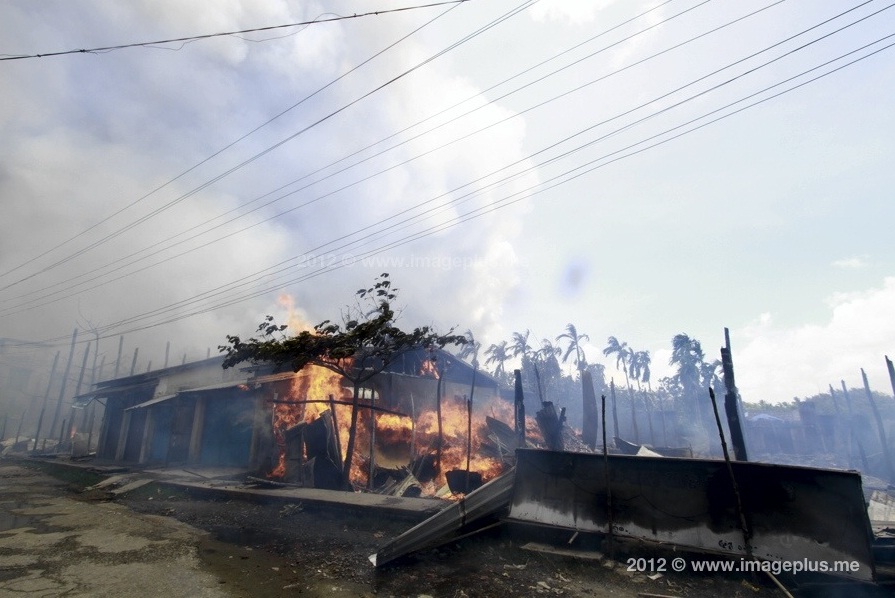Photo: Htoo Tay Zar
Since Hillary Clinton’s historic visit to Myanmar, the nation’s reforms have drawn the world’s attention. The end of a half century of military rule leaves Myanmar with countless challenges. Recently, the violence in western Myanmar’s Rakhine State has become a controversial topic. Global bodies, human rights organizations, world leaders and US lawmakers have rushed to condemn what they see as the treatment of these stateless people.
The reality of the history of the Rohingya is not as clear as many believe. A campaign of disinformation has led to denunciation of a policy in Myanmar that at best, is grossly exaggerated, and at worst, does not exist. Headlines have screamed the words “ethnic cleansing and “pogrom.” Myanmar history of secrecy and disregard of human rights under the previous military government has lent credibility to this campaign.
Muslims have been living in Rakhine State (formerly known as Arakan State) for centuries. They share only their faith with the Rohingyas and have coexisted peacefully with Buddhist Rakhines. The term Rohingya describes a people from the origin of Bengali. Much of the violence stems from the questionable arrival and settlement status of these individuals.
The unrest in Rakhine State was sparked by the brutal rape and murder of a Rakhine woman by 3 Muslims, 2 of whom were Rohingya according to eyewitnesses. Retaliation was swift and violent. 9 Muslims were killed by a mob of hundreds of angry residents, presumably native Rakhines.
After days of unrest, Rohingya living in the villages of the district of Maung Taw intensified the violence by burning down homes, banks, hospitals and food stalls. The Myanmar government announced a curfew for the affected area, but the violence on both sides continued. Thousands of Rakhine people have taken refuge at emergency camps; children are unable to attend school; people are not receiving even the most basic medical attention. Rakhines have lost all of their possessions along with their homes and businesses. Many have family members who have been killed.
Despite the hardships endured by both groups, international media have largely ignored the Rakhines while telling story after story about the stateless Rohingyas. Furthermore, International NGOs, including UNHCR who have long provided aid to the Rohingyas, are now providing substantial assistance to the Rohingyas while paying scant attention to the other victims of this violence. In protest, some monks and monasteries have declined to accept INGO support.
Democracy icon Daw Aung San Suu Kyi did speak about the violence, correctly stating that this issue must to be solved by applying a fair standard of rule of law in the affected area and to the Myanmar immigration process. Reformist President U Thein Sein suggested that illegal Rohingya refugees could be handed over to the UNHCR to house them in UN operated refugee camps. Alternatively he suggested that they be absorbed by another state. The UNHCR rejected these proposals despite their concerns about the now stateless inhabitants. Leading Myanmar political figures, including the leadership of 88 Generation Students, agreed that some Rohingya are likely eligible for Myanmar citizenship.
This is an immigration issue, a citizenship issue, a violent disagreement about who exactly is entitled to Myanmar citizenship. The international media have wrongly identified it as a religious clash between Muslims and Buddhists in Myanmar.
The riots started in and spread in towns and villages where the majority population was Rohingya, not native Rakhine. Several Rohingya combatants were rightfully detained by law enforcement authorities due to suspected criminal activity. Human rights groups and many INGO’s have longstanding relationships with the Rohingya populations and relatively little contact with Rakhine populations. Unfortunately NGO’s and Human Rights organizations are as much about raising money as raising awareness. Their accounts, the Rohingya accounts, have been repeated by news agencies, portrayed as fact and not as a one-sided account of Rohingyas and NGO’s who have a natural interest in continuing this narrative. Investigations and interviews of eyewitnesses from all sides would shed light on the situation there.
Photo: Htoo Tay Zar
While Myanmar people of all political and ethnic groups around the world have emphasized that this is not a clash of religions but an immigration issue, media are repeating falsified accounts and culling images from unrelated sources. Photos of Buddhist monks and dead bodies from unrelated events have been misrepresented and splashed across headlines worldwide.
Myanmar is still in the early stages of transformation to democracy. The government, opposition groups and the Myanmar public have to tackle several serious issues. There is violence in Rakhine State, and in violence there are innocent victims on all sides. But there is no ethnic cleansing, no genocide. There are doubtless some longstanding Bengali residents who deserve citizenship, and they should get it. With respect to those who do not qualify, false accusations and refusal to consider reasonable proposals will undoubtedly lead to more violence.
The author is based in Singapore, she covers issues and affairs related to Myanmar on Global Voices and Myanmar Netizens.
 Facebook
Facebook  Twitter
Twitter  Soundcloud
Soundcloud  Youtube
Youtube  Rss
Rss 
